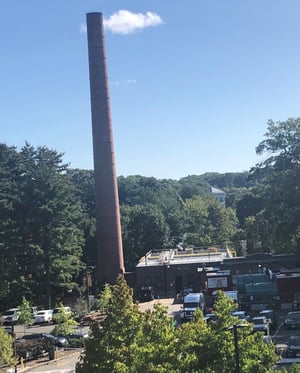Draft is one of the most critical aspects in any boiler system. Too much negative draft can cause a flame to be pulled off the burner head whereas too much positive can create excessive heat at the head and cause premature failure. We call it the “potato chip effect” where the burner diffuser is cooked. All firetube, water tube and cast iron boilers and specific burners alike require a specific amount of draft whether it be positive or negative. With our vast experience we feel as if we’ve “seen it all” however, there’s always a new situation that can truly make us scratch our collective heads.
A draft fan can be used to control draft in a boiler. Depending on boilers design, the draft fan either forces the air through the boiler (forced draft) or pulls the air through the boiler (induced draft). In some situations, a combination of the two is used to ensure a balanced draft which is the goal of any setup. Typically, we like to install opposed blade draft dampers to gain further control of the draft. The dampers rest just below the outlet of the boiler and rest on a shaft where we install an Autoflame servo motor. The servo motor modulates the dampers as needed throughout the firing range. The great thing about this setup is it allows us to control the draft within the boiler but it also is integrated into the overall Autoflame Combustion Control System.
Some applications have such a tremendous amount of draft (due to a very high smoke stack)  therefore, we install a barometric damper to regulate the draft in conjunction with the opposed blade dampers. These dampers are adjustable via weights that are built into the back side of the unit. Barometric dampers have been around for a very long time and are very practical.
therefore, we install a barometric damper to regulate the draft in conjunction with the opposed blade dampers. These dampers are adjustable via weights that are built into the back side of the unit. Barometric dampers have been around for a very long time and are very practical.
Other applications where the boiler cannot achieve enough draft is by installing a fan at the top of the stack/vent. These fans pull the smoke up the breeching to ensure the products of combustion safely exit into the atmosphere.
Another situation we’ve seen is when there is a long vertical run within the boiler plant which eventually turns at 90° and vertically climbs to its exit area. In these instances, it is very difficult to draw draft due to the lengthy horizontal therefore, an inline draft fan would be used to pull the products of combustion from the boiler and push it up the chimney thereafter ensuring a safe condition.
Condensing Boilers
Condensing boilers that operate via sealed combustion through a nearby wall to atmosphere are typically absent from any draft issues. There are cases where if the boiler is vented in an area that has a lot of atmospheric turbulence, trouble can occur. When venting a condensing boiler vertically through a roof there are challenges with draft if the run is too long. Sure you will get some natural draft, but not a significant amount therefore, the boiler must rely on its internal fan to “push” the products of combustion up into the atmosphere. Condensing boiler exhaust gases have a lower temperature therefore achieving decent draft can be challenging. When considering the installation of a new condensing boiler please ensure your venting options fall within range of the manufacturers recommendations.
If you have a situation regarding a draft issue at your facility, please do not hesitate to give us a call. There’s a good chance that we’ve already seen it.


